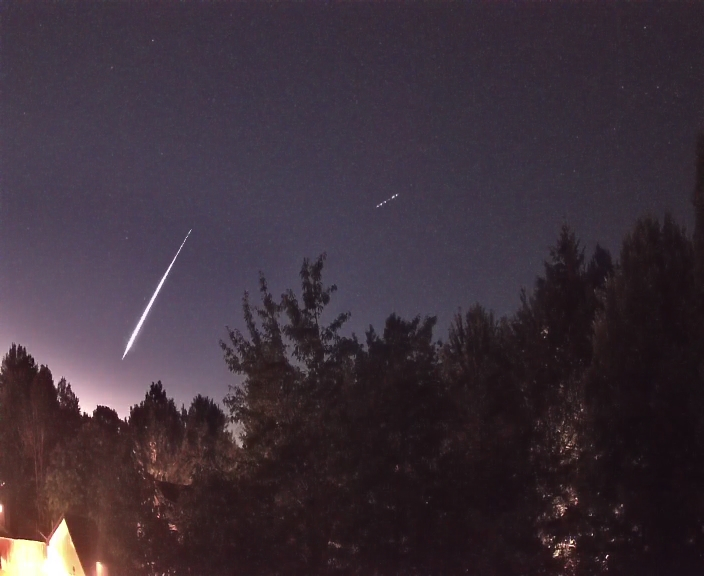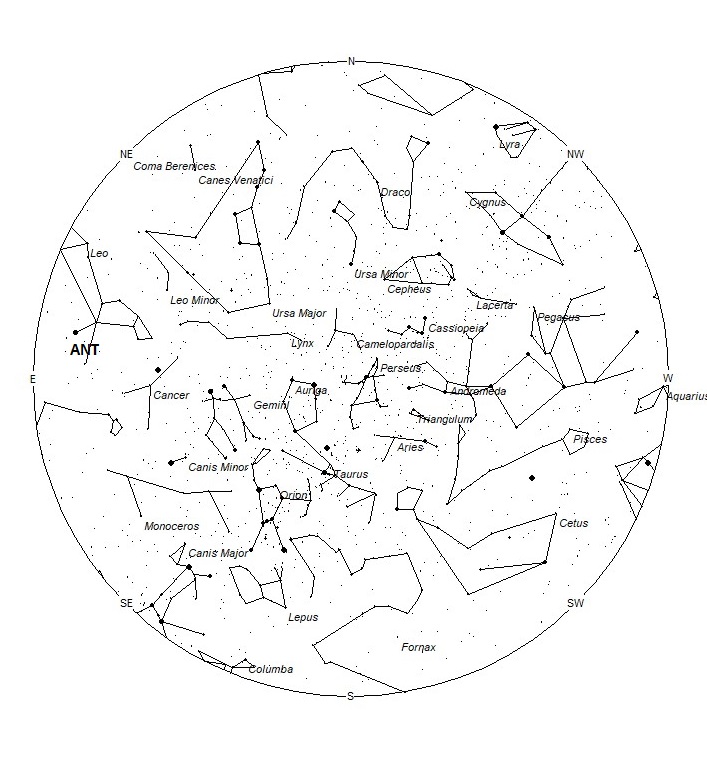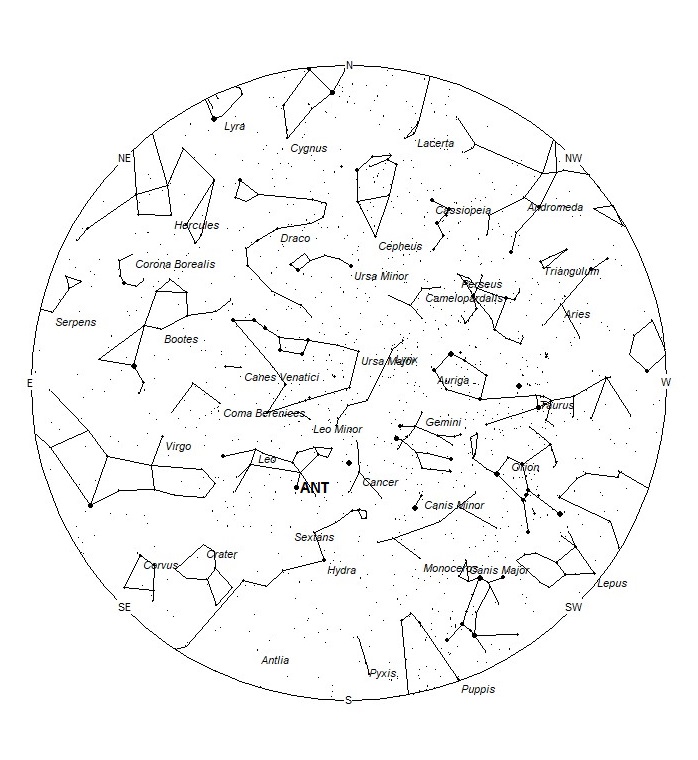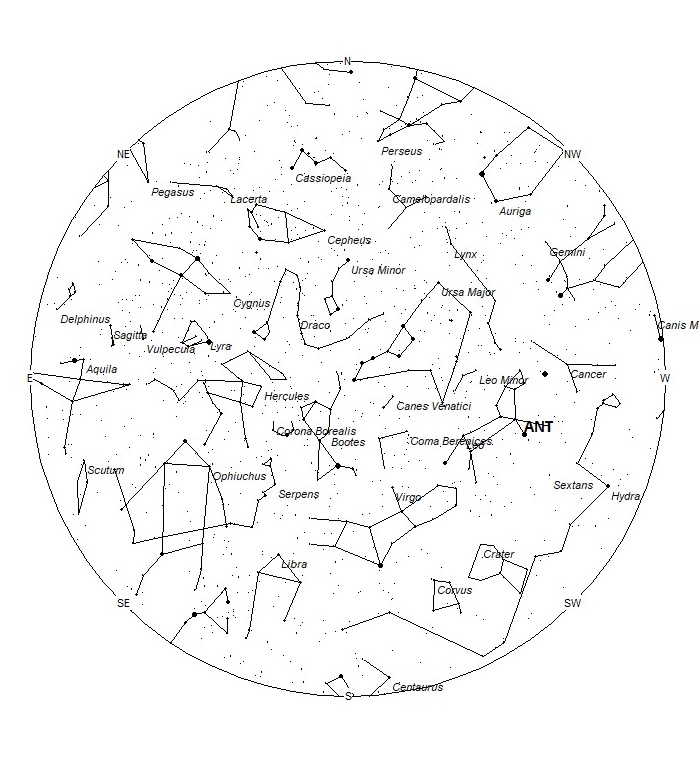 Jordan Ragsdale captured this bright fireball using his AllSky Camera System on August 12, 2022, at 22:03 MDT (4:03 UT on August 13) from Eagle, Idaho, USA. Note that the secondary streak is an aircraft and not another meteor. For more information on this event visit: https://fireballs.imo.net/members/imo_view/event/2022/5079 ©Jordan Ragsdale
Jordan Ragsdale captured this bright fireball using his AllSky Camera System on August 12, 2022, at 22:03 MDT (4:03 UT on August 13) from Eagle, Idaho, USA. Note that the secondary streak is an aircraft and not another meteor. For more information on this event visit: https://fireballs.imo.net/members/imo_view/event/2022/5079 ©Jordan RagsdaleDuring this period, the moon reaches its full phase on Sunday February 5th. At that time the moon will lie opposite the sun and will remain above the horizon all night long. As the week progresses the moon will rise later each evening providing a small window of opportunity to view the sky under dark conditions. Unfortunately, this time of night provides the least amount of meteor activity of only 2-3 meteors per hour. The estimated total hourly rates for evening observers this week should be near 2 as seen from mid-northern latitudes (45N) and 2 as seen from tropical southern locations (25S) For morning observers, the estimated total hourly rates should be near 3 as seen from mid-northern latitudes (45N) and 7 as seen from tropical southern locations (25S). Rates are reduced by bright moonlight during this period. The actual rates seen will also depend on factors such as personal light and motion perception, local weather conditions, alertness, and experience in watching meteor activity. Note that the hourly rates listed below are estimates as viewed from dark sky sites away from urban light sources. Observers viewing from urban areas will see less activity as only the brighter meteors will be visible from such locations.
The radiant (the area of the sky where meteors appear to shoot from) positions and rates listed below are exact for Saturday night/Sunday morning February 4/5. These positions do not change greatly day to day so the listed coordinates may be used during this entire period. Most star atlases (available at science stores and planetariums) will provide maps with grid lines of the celestial coordinates so that you may find out exactly where these positions are located in the sky. I have also included charts of the sky that display the radiant positions for evening, midnight, and morning. The center of each chart is the sky directly overhead at the appropriate hour. These charts are oriented for facing south but can be used for any direction by rotating the charts to the desired direction. A planisphere or computer planetarium program is also useful in showing the sky at any time of night on any date of the year. Activity from each radiant is best seen when it is positioned highest in the sky, either due north or south along the meridian, depending on your latitude. It must be remembered that meteor activity is rarely seen at the radiant position. Rather they shoot outwards from the radiant, so it is best to center your field of view so that the radiant lies at the edge and not the center. Viewing there will allow you to easily trace the path of each meteor back to the radiant (if it is a shower member) or in another direction if it is sporadic. Meteor activity is not seen from radiants that are located far below the horizon. The positions below are listed in a west to east manner in order of right ascension (celestial longitude). The positions listed first are located further west therefore are accessible earlier in the night while those listed further down the list rise later in the night.
These sources of meteoric activity are expected to be active this week.
Details on each source will resume next week when observing conditions will have improved.
The list below offers the information in tabular form. Rates and positions are exact for Saturday night/Sunday morning except where noted in the shower descriptions.
| SHOWER | DATE OF MAXIMUM ACTIVITY | CELESTIAL POSITION | ENTRY VELOCITY | CULMINATION | HOURLY RATE | CLASS |
| RA (RA in Deg.) DEC | Km/Sec | Local Standard Time | North-South | |||
| Anthelions (ANT) | – | 09:56 (149) +11 | 30 | 01:00 | 1 – <1 | II |
| alpha Centaurids (ACE) | Feb 08 | 15:31 (233) +27 | 57 | 08:00 | <1 – 1 | II |
Class Explanation: A scale to group meteor showers by their intensity:
- Class I: the strongest annual showers with Zenith Hourly Rates normally ten or better.
- Class II: reliable minor showers with ZHR’s normally two to ten.
- Class III: showers that do not provide annual activity. These showers are rarely active yet have the potential to produce a major display on occasion.
- Class IV: weak minor showers with ZHR’s rarely exceeding two. The study of these showers is best left to experienced observers who use plotting and angular velocity estimates to determine shower association. These weak showers are also good targets for video and photographic work. Observers with less experience are urged to limit their shower associations to showers with a rating of I to III.







 You saw something bright and fast? Like a huge shooting star? Report it: it may be a fireball.
You saw something bright and fast? Like a huge shooting star? Report it: it may be a fireball.  You counted meteors last night? Share your results with us!
You counted meteors last night? Share your results with us!  You took a photo of a meteor or fireball? You have a screenshot of your cam? Share it with us!
You took a photo of a meteor or fireball? You have a screenshot of your cam? Share it with us!  You caught a meteor or fireball on video? Share your video with us!
You caught a meteor or fireball on video? Share your video with us!